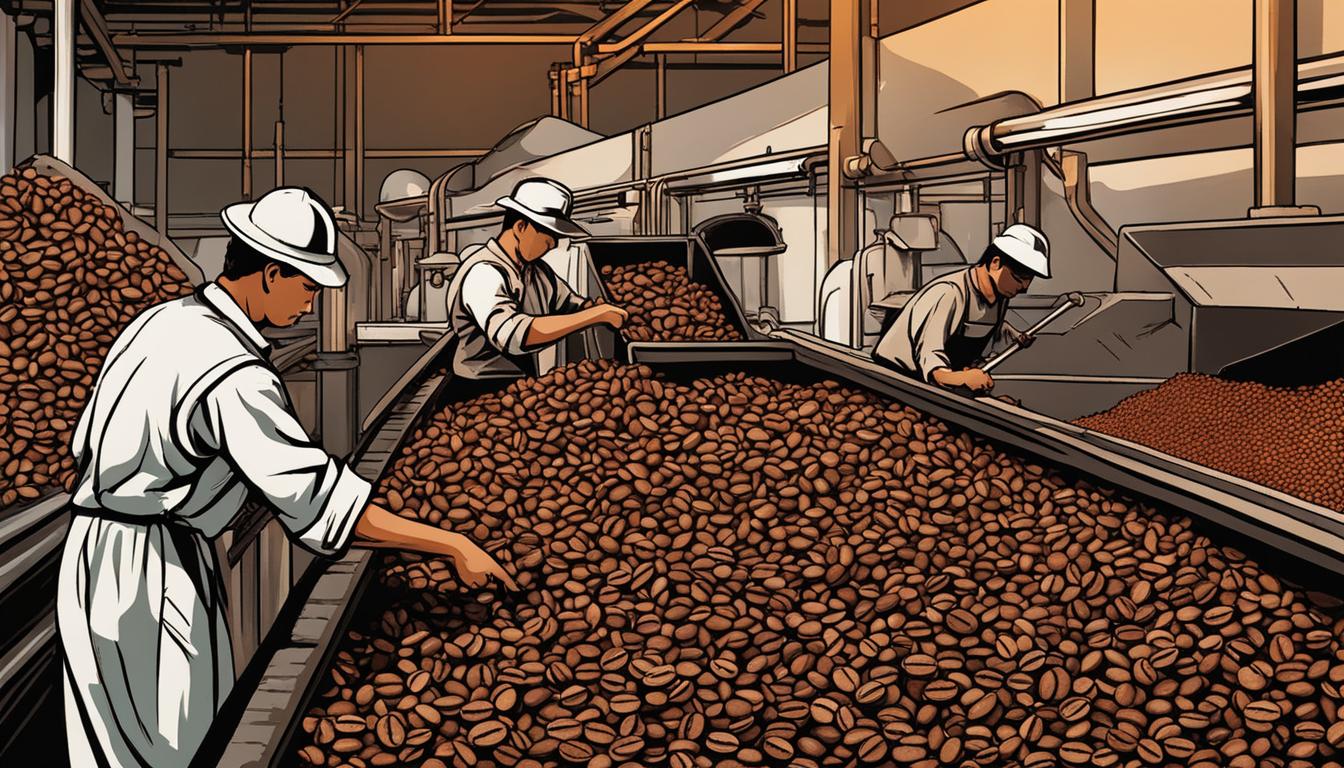What is the impact of air exposure on roasted coffee beans?
Welcome to our blog, where we explore the fascinating world of coffee. Today, we delve into the effects of air exposure on roasted coffee beans. As coffee enthusiasts, we understand the importance of preserving the freshness and flavor of this beloved beverage. But did you know that air exposure can have a significant impact on the quality of coffee beans?
Page Contents
In the coffee industry, air exposure is a prevalent concern. From the roasting process to packaging and storage, coffee beans are exposed to air at various stages, which can have both positive and negative consequences. Understanding the effects of air exposure is crucial for coffee lovers, industry professionals, and anyone who wants to ensure the best possible coffee experience.
Air exposure can lead to the emission of volatile organic compounds (VOCs) from roasted coffee beans. These VOCs, including diacetyl and 2,3-pentanedione, can pose health risks, particularly to workers in coffee production facilities. Inhalation of these compounds can cause respiratory issues and other health complications.
Your Perfect Brew Awaits with Our Premium Coffee Beans
Indulge in the rich, aromatic experience of our carefully selected coffee beans, sourced from the finest estates. Each bean is roasted to perfection, ensuring a smooth, full-bodied flavor that will awaken your senses and elevate your coffee moments.
Discover the difference quality makes - try our premium coffee beans today and elevate your coffee experience to new heights!
But it’s not all doom and gloom! By implementing preventive measures and proper handling techniques, we can mitigate the risks of air exposure and preserve the freshness and flavor of roasted coffee beans. Let’s delve deeper into the impact of air exposure and explore ways to prevent and mitigate it.
Key Takeaways:
- Air exposure can negatively affect the quality of roasted coffee beans and pose health risks to coffee production workers.
- Volatile organic compounds (VOCs), such as diacetyl and 2,3-pentanedione, emitted during coffee production, can impact respiratory health.
- Preventive measures, including controlling emissions, proper ventilation, and using airtight containers, can help minimize the risks of air exposure.
- Café workers, who have lower exposure levels compared to production facilities, can benefit from proper ventilation and minimal exposure to coffee flavorings.
- Proper storage techniques, such as using opaque, airtight containers at room temperature, can help preserve the freshness and flavor of roasted coffee beans.
The impact of air exposure on coffee production workers
When it comes to the effects of air exposure on coffee production workers, thorough exposure assessment is crucial. In particular, the presence of volatile organic compounds (VOCs), such as diacetyl and 2,3-pentanedione (acetyl propionyl), in coffee roasting and packaging facilities can pose significant health risks.
During the assessment, it was found that personal exposures to diacetyl and 2,3-pentanedione were the lowest for non-production workers in facilities that did not flavor coffee. On the other hand, tasks, activities, and sources associated with flavoring in flavored coffee facilities resulted in some of the highest mean and 95th percentile estimates for both diacetyl and 2,3-pentanedione.
To mitigate these risks, it is essential to focus on controlling emissions at grinding machines and flavoring areas. Additionally, isolating higher exposure areas, such as flavoring, grinding, and packaging areas, from the main production space and non-production spaces is of utmost importance in maintaining exposure control.
Here is a table summarizing the exposure assessment results:
| Worker group | Exposure to Diacetyl (GM ppb) | Exposure to 2,3-Pentanedione (GM ppb) |
|---|---|---|
| Non-production workers in facilities that do not flavor coffee | 0.9 | 0.7 |
| Flavoring workers | 34 | 38 |
| Packaging workers | 27 | 19 |
| Grinder operators | 26 | 22 |

By implementing these measures and raising awareness about the potential risks, we can ensure a safer working environment for coffee production workers.
The impact of air exposure on café workers
Café workers, including baristas, are also susceptible to the effects of air exposure in the coffee industry. While cafés generally have a lower risk of exposure compared to flavored coffee facilities, it is still essential to understand and minimize the potential health risks.
One of the primary concerns in café settings is the presence of volatile organic compounds (VOCs) such as diacetyl and 2,3-pentanedione (acetyl propionyl). These compounds can be released from roasted coffee and coffee flavorings, posing respiratory health risks to workers.
However, studies have shown that baristas in cafés maintain mean full-shift exposures below the NIOSH Recommended Exposure Limit (RELs) for diacetyl (GM 4.1 ppb) and 2,3-pentanedione (GM 4.6 ppb). This indicates that the risk of exposure for café workers is relatively low.
To further protect café workers from the potential health risks associated with air exposure, it is crucial to ensure proper ventilation in café environments. Adequate ventilation helps to minimize the concentration of VOCs in the air, reducing the likelihood of inhalation and subsequent health effects.
In addition, minimizing exposure to coffee flavorings can also contribute to the well-being of café workers. Flavorings are often sources of VOCs, and reducing their use or finding alternative methods to control their emission can help mitigate the risks of air exposure.
| Key Findings | Diacetyl (ppb) | 2,3-pentanedione (ppb) |
|---|---|---|
| Mean full-shift exposures for baristas | 4.1 | 4.6 |
By employing these preventive measures, café owners and managers can create a safer and healthier working environment for their staff. Prioritizing proper ventilation and minimizing exposure to coffee flavorings not only protects café workers from the potential health risks of air exposure but also ensures the continuation of exceptional coffee service to customers.
The impact of air exposure on coffee bean storage
When it comes to preserving the freshness and flavor of your roasted coffee beans, proper storage is essential. Air exposure can have detrimental effects, compromising the quality of your coffee. Here are some tips for maintaining the optimal taste and aroma of your coffee beans:
- Store your roasted coffee beans in an opaque, airtight container to protect them from air exposure. This will help preserve their freshness for a longer period.
- Avoid clear canisters that allow light to penetrate as light exposure can degrade the flavor of the coffee. Opt for containers that shield your beans from both air and light.
- Invest in storage canisters with an airtight seal. The coffee’s retail packaging is generally not designed for long-term storage, so transferring your beans to airtight containers is recommended.
- Consider buying smaller batches of freshly roasted coffee more frequently. This ensures that you’re using beans at their peak freshness and reduces the amount of time they spend exposed to air.
- Grind only the amount of coffee needed immediately before brewing. This minimizes air exposure and helps maintain the quality of your beans.
Following these practices will help you preserve the full flavor and aroma of your coffee beans, ensuring a delightful brewing experience every time.

| Storage Recommendations | Benefits |
|---|---|
| Opaque, airtight containers | Preserves freshness and flavor |
| Avoiding light exposure | Prevents flavor degradation |
| Investing in airtight canisters | Ensures long-term freshness |
| Buying smaller batches | Maximizes freshness |
| Grinding only what’s needed | Minimizes air exposure |
The impact of air exposure on coffee bean freshness
Coffee beans begin to lose freshness almost immediately after roasting. It is crucial to take proper measures to preserve their flavor and quality. Here are some tips for ensuring the freshness of your coffee beans:
Buying the right amount
When purchasing coffee beans, it is recommended to buy smaller batches that will be consumed within one or two weeks. Buying in smaller quantities ensures that you are always using freshly roasted beans and minimizing air exposure.
Storing in airtight containers
Exposure to air can degrade the quality and flavor of coffee beans. Dividing your coffee supply into several smaller portions and storing them in airtight containers can help reduce air exposure and preserve freshness. Make sure the containers have a tight seal to prevent air from entering.
Freezing coffee beans
Freezing coffee beans can help extend their freshness. However, it is essential to use a truly airtight container to prevent freezer burn and moisture from affecting the beans’ flavor. When using frozen beans, only take out the amount needed for a week and promptly return the rest to the freezer to maintain freshness.
By following these guidelines, you can ensure that your coffee beans maintain their optimal freshness and flavor for a delightful cup of coffee every time.
The image illustrates the process of freezing coffee beans, which is one of the methods to extend their freshness.
Conclusion
Air exposure is a crucial factor that can greatly impact the quality of roasted coffee beans. It not only affects the preservation of freshness and flavors but also poses health risks, particularly to coffee production workers. The emission of volatile organic compounds during the roasting and flavoring process can have detrimental effects on respiratory health.
Fortunately, there are preventive measures that can be taken to mitigate these risks. Controlling emissions, ensuring proper ventilation, and implementing stringent hygiene protocols are essential in minimizing the negative effects of air exposure. Additionally, storing roasted coffee beans in airtight containers at room temperature can help preserve their quality and taste.
By adopting these preventive measures, we can ensure a safer working environment for coffee industry workers while preserving the freshness and flavor of roasted coffee beans. It is our collective responsibility to prioritize health and the quality of the coffee we enjoy. Let’s take the necessary steps to protect ourselves, our workers, and the integrity of this beloved beverage.
FAQ
What is the impact of air exposure on roasted coffee beans?
Air exposure can have significant effects on roasted coffee beans, including the emission of volatile organic compounds (VOCs) that can negatively impact the respiratory health of coffee production workers.
What is the impact of air exposure on coffee production workers?
Exposures to VOCs during coffee roasting, packaging, grinding, and flavoring can negatively impact the respiratory health of workers. Inhalational exposures to diacetyl and 2,3-pentanedione, common VOCs in roasted coffee and coffee flavorings, can cause obliterative bronchiolitis.
What is the impact of air exposure on café workers?
Baristas in cafés have mean full-shift exposures below the recommended exposure limits for diacetyl and 2,3-pentanedione. Ensuring proper ventilation and minimizing exposure to coffee flavorings can help protect café workers from the health risks of air exposure.
What is the impact of air exposure on coffee bean storage?
To preserve the freshness and flavor of roasted coffee beans, it is recommended to store them in an opaque, airtight container at room temperature. Clear canisters should be avoided as they allow light exposure, which can compromise the taste of the coffee.
What is the impact of air exposure on coffee bean freshness?
Coffee beans begin to lose freshness almost immediately after roasting. Buying smaller batches of freshly roasted coffee, dividing the coffee supply into several smaller portions stored in airtight containers, and freezing coffee beans can help minimize air exposure and maintain the quality and freshness of the coffee beans.
What are the preventive measures for air exposure?
Preventive measures for air exposure in the coffee industry include controlling emissions, proper ventilation, and using airtight containers for storage. These measures help mitigate the health risks associated with air exposure and ensure a safer working environment for coffee industry workers.




